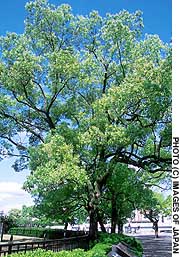A magnificent camphor tree in Hiroshima, where the species is the official city tree in commemoration of those that survived the 1945 atomic bombing.
A camphor by any other name
By Mark Brazil | Aug 1, 2002
Growing among the the laurel-dominated evergreen forests of central and southern Japan is a tree with a host of names and a host of uses.This member of that dominant family (Lauraceae) goes by the name kusu-no-ki (tree that came from the south) in Japanese; while in English it can be called either laurel camphor, camphor laurel, gum camphor or, simply, camphor tree. In the universal Linnaean language of botanists and horticulturalists, it is Cinnamomum camphora.
The camphor tree’s natural range spans the warm, humid southern parts of Japan and adjacent areas of East Asia, particularly the Korean Peninsula, Taiwan and China. Elsewhere, it has also been successfully cultivated as an ornamental, a windbreak and a shade tree in subtropical regions of India, southern parts of Europe, California, Florida, various other southern states — and even in Argentina.
As its scientific name indicates, the camphor tree is a close relative of Cinnamomum zeylanicum, from the dried bark of which comes cinnamon, a spice used in food and drinks since ancient times.
Like that spicy cousin, the scented camphor tree can grow to a great size, reaching as high as 20-25 meters with a bole that may exceed 9 meters in circumference. In some specimens the dark, gray-brown, rugged main trunk may become very stout, while in others it may divide into several secondary trunks. Whichever, the main and subsidiary trunks support a dense, glossy-green canopy that creates a deep shade that is particularly welcome in the city streets and parks where the tree is often planted.
One of the most astonishing attributes of these impressive trees, however, is their life span. The dignified camphor tree standing on the southern side of the North Gate of Shoren’in Shrine in Kyoto, for example, is several hundred years old and has been registered both as a giant tree and a historical tree, as well as being a city-designated natural monument.
Not to be outdone by Kyoto, the specimen east of the precinct at Yamada Shrine in Tottori is said to have been planted more than 1,000 years ago, and is considered sacred by people in that area of the Sea of Japan coast. Even older, however, is the giant camphor tree at Atsuta Jingu in Nagoya, which is said to have been planted 1,300 years ago by the early Heian Period priest Kukai (Kobo Daishi), founder of the Shingon sect of Buddhism.
But if you thought 1,300 years was old . . .
Camphor trees can be seen throughout Saga Prefecture in northern Kyushu, where it is the prefectural tree, but the giant specimen at Kawago in Takeo City takes the cinnamon biscuit for venerability. Also designated a national natural monument, and ranked as the country’s third-largest tree, it stands 25 meters high, has a deep-root circumference of 33 meters, and its surface roots span 26 meters east-west and 33 meters north-south. It is more than 3,000 years old — having first sprouted in the prehistoric time of the Jomon culture, long before rice cultivation was even introduced to these islands.
Takeo City seems well-favored by giants. Besides that awesome camphor tree, another at Takeo Shrine is ranked sixth nationally in size, while that at Tsukasaki is ranked third in size in the prefecture.
However, camphor trees are not only long-lived, but they are also astonishingly vigorous and capable of surviving even the worst that man can throw at them. A specimen at the Sanno Shrine in Nagasaki was designated a natural monument by that city on Feb. 15, 1969, because it had survived the U.S. atomic bombing of Aug. 9, 1945. Then, on Nov. 3, 1973, the camphor tree was made the official tree of Hiroshima to commemorate those trees that not only survived the U.S. atomic bombing of the city on Aug. 6, 1945, but then recovered quickly and gave inspiration to the people trying to rebuild their lives.
The camphor tree’s leaves are simple and alternate; the blades, often with wavy margins, are usually 4-10 cm long and 2-5 cm across. The central vein and the two side-branching ones are particularly prominent. Cut a stem or bruise a leaf and you will immediately notice the strong aroma of camphor that emanates. The flowers, though small individually, are noticeable because they occur in loose panicles, making the greenish-white to cream blooms conspicuous. The tree’s reddish or blackish berries, much like those of the cinnamon tree, are often abundant on mature specimens, attracting birds to feast on these fruits in winter.
The insecticidal properties of camphor are particularly significant. Both the aromatic wood itself — which repels insects and has long been used to moth-proof clothes — and the chemical camphor derived from it provide effective protection against insects. Consequently, cabinets for storing natural-history specimens are often made of camphor wood to prevent insects reaching and damaging the contents.
The chemical camphor, a ketone with a distinctive and pungent smell, is derived from young shoot clippings, roots and wood chips. These are distilled using steam to produce camphor crystals and camphor oil. Camphor is used medicinally in massage compounds to ease bruises, inflammation and joint pains, and in lip salve and inhalants. Locally, it numbs the peripheral sensory nerves and has mild antiseptic properties.
In fact, the herbal medicinal uses of camphor are many and varied. It is apparently helpful for colds, chills and various nervous, stomach and bowel complaints, as a stimulant and even as a sedative liniment. Be sure to use it in moderation though, as in large doses it is acrid and very poisonous.
All in all, that’s quite some tree in our midst.

